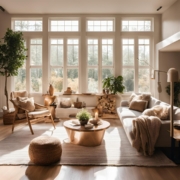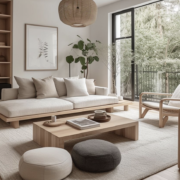Why Accurate Measurements Matter
Understanding Room Measurements for Your Space
Accurate measurements are crucial in every room of your home. For example, in a dining room, knowing the dimensions of your table along with the clearance needed for chairs can help you choose a table that complements the space rather than overwhelming it. A well-measured room allows for more comfortable dining experiences, where guests can easily move in and out of their seats.
Understanding the importance of room measurements ensures that every piece of furniture fits well within the space.
Proper room measurements can transform how you experience your dining area, making meals more enjoyable.
When it comes to custom furniture, size is everything. A sofa that’s too big can make a room feel cramped, while a table that’s too small can leave the space feeling incomplete. Accurate measurements help you:
When evaluating options, always consider how room measurements affect the overall functionality and aesthetics.
Taking accurate room measurements can help you avoid costly mistakes in furniture selection.
Precise room measurements also play a vital role in the flow of movement within your space.
Remember, accurate room measurements help you avoid the common pitfalls of furniture arrangement, ensuring that your space feels balanced and well-utilized.
Ensure your furniture fits perfectly.
Maximize functionality and room flow.
When you utilize room measurements effectively, your space becomes not only functional but also visually appealing.
Avoid costly mistakes or uncomfortable layouts.
Plan for a cohesive design that balances proportion and style.
With accurate room measurements, you can create a harmonious balance that enhances both style and practicality.
Understanding room measurements is vital when selecting furniture that fits well and enhances both aesthetics and functionality.
Don’t underestimate how essential accurate room measurements are for achieving a well-executed design.
Mastering room measurements is essential for ensuring that your selections harmonize with the overall design.
What You’ll Need
Having proper tools will ensure that your room measurements are precise, which can make a significant difference in your design.
Before you start, gather these tools:
A tape measure (8 meters or longer for larger spaces).
A pen and paper (or a phone/tablet for notes).
A friend or family member (helpful for big areas).
A floor plan (if you don’t have one, sketch a simple layout).
Step 1: Measure Room Dimensions
When measuring room dimensions, it’s beneficial to use the longest walls as a reference. For instance, if your living room is an L-shape, it might be helpful to measure the longest part first, then address the shorter wall separately. This method can streamline the measuring process and reduce the potential for errors.
Taking accurate room measurements is crucial; if your living room is L-shaped, measure the longest walls first for the best results.
Measure the length and width of the entire room.
Note down wall-to-wall distances.
If the room isn’t perfectly rectangular, measure each section separately.
Base your furniture choices on the precise room measurements you’ve gathered.
Step 2: Focus on the Placement Area
Length & Width: Measure the exact spot for your new piece (e.g., wall length for a sofa).
Consider using painter’s tape to mark the dimensions of your future furniture on the floor. This visual representation can help you assess how the piece will fit in the space and if it allows for comfortable movement. For instance, if you’re planning to place a sofa, marking out its dimensions can reveal if it will block pathways or feel too imposing in the room.
Clearance: Leave 60–90 cm of walking space around furniture.
Obstructions: Consider doors, windows, columns, or built-ins that may interfere with placement.
Step 3: Measure Ceiling Height
For tall furniture like cabinets or bookshelves:
Measure from floor to ceiling.
If you know your room measurements, you can confidently select furniture that matches the scale of your space.
When measuring ceiling height, don’t forget to check how tall your furniture items are, especially in compact spaces. For example, a tall bookshelf might look great but could overwhelm a small room if it reaches the ceiling. Consider the overall balance of the room—tall furniture can make a space feel smaller if not proportionately balanced with lower items.
Check for hanging lights, beams, or fans.
Ensure there’s clearance for doors or drawers to open fully.
Step 4: Consider Additional Features
In addition to electrical outlets and vents, think about how natural light will interact with your furniture. For instance, placing a sofa near a window can be visually appealing, but it might also hinder light flow if the piece is too large. Understanding how light affects your room can inform not only furniture placement but also material choices, such as lighter colors to enhance brightness.
Incorporating accurate room measurements into your design process will save you time and prevent unnecessary headaches.
Using accurate room measurements streamlines the design process, leading to more cohesive results.
Electrical outlets: Keep space for lamps, TVs, or electronics.
Heating/Cooling vents: Avoid blocking airflow.
Existing furniture: Measure any items you plan to keep so everything complements each other.
Using graph paper can also assist in visualizing your layout. You can represent each piece of furniture to scale, allowing you to experiment with different arrangements. For example, if you’re considering an L-shaped sofa, drawing it out on graph paper can help you see if it fits realistically in your room’s dimensions.
Double-check everything: Measure twice to avoid errors.
Think vertically: Don’t ignore furniture height.
Plan for traffic flow: Ensure pathways stay clear.
Use interior design apps: They can help you visualize furniture placement.
How Cozyology Furniture Can Help
Remember, the key to a successful home design starts with accurate room measurements.
With careful attention to room measurements, you can ensure that your design intentions are fully realized.
At Cozyology Furniture, we offer personalized consultations to discuss your measurements and design preferences. This service ensures that your vision aligns with practical space considerations. If you have specific styles in mind, we can guide you on how to adapt those styles to your unique room dimensions, enhancing both aesthetics and function.
Once you have your measurements, simply share them with us. At Cozyology Furniture, our interior design packages make sure your custom furniture is tailored to your exact space. From floor plans to furniture selection, we help transform your ideas into reality—delivering pieces that fit perfectly, function beautifully, and elevate your home.



